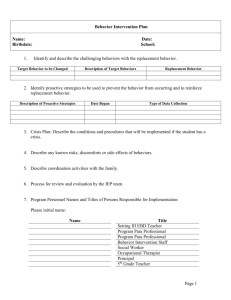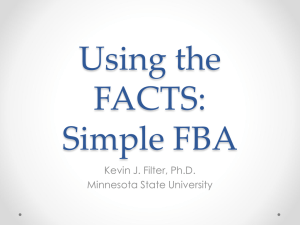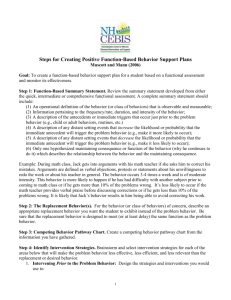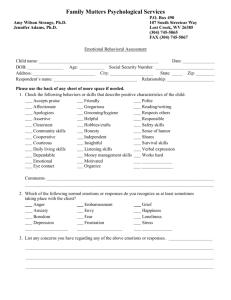Regional Forum Handout Packet - NYS PBIS Technical Assistance
advertisement
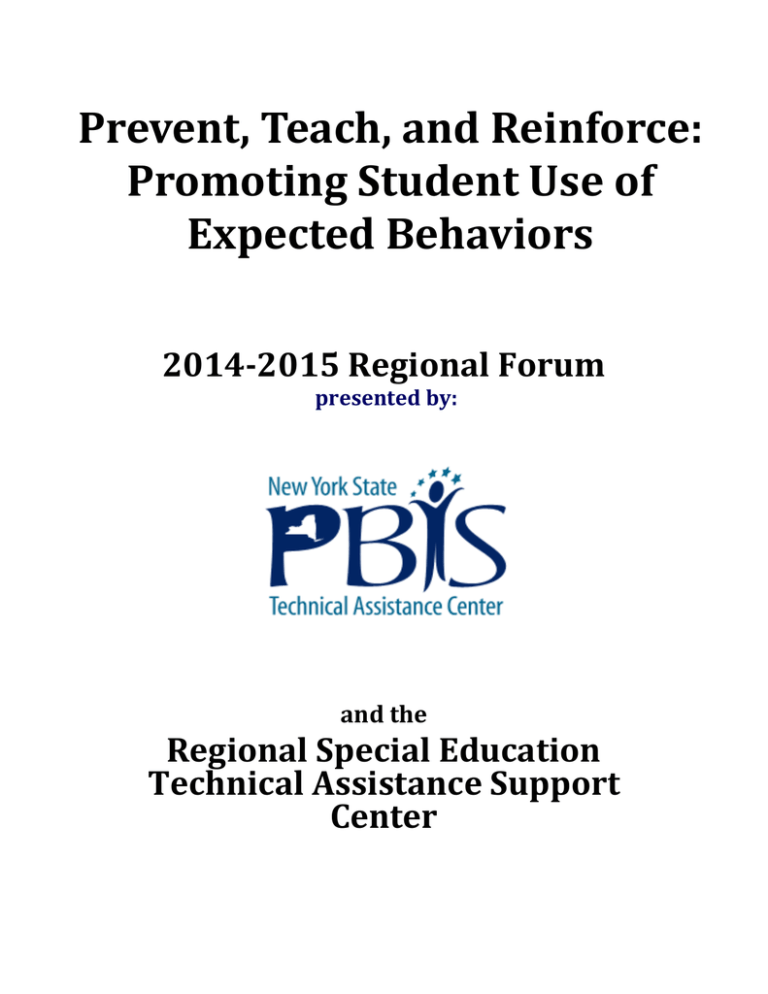
Prevent, Teach, and Reinforce: Promoting Student Use of Expected Behaviors 2014-2015 Regional Forum presented by: and the Regional Special Education Technical Assistance Support Center Table of Contents for Handout Packet Table of Contents for Flash Drive Materials……...……………………………………………...3 Turn & Talk ~ Check In/Check Out Role Play…………………………………………….….…7 Turn & Talk – Sample Lesson Plan…..…...…...………………...……………….……………... 8 Behavioral Pathway ………..…………………………………………………………………... 11 Turn & Talk ~ Scenario 1………………………………………………………………………. 12 Turn & Talk ~ Scenario 2…………………………………………………………………….… 13 Turn & Talk ~ Setting Event Strategies………………………………………………………… 14 Turn & Talk ~ Antecedent Prevention Self-Assessment…………………………………….…..15 Turn & Talk ~ Teaching Functionally Equivalent Replacement Behaviors…………………… .16 Behavior Pathway Diagram……………………………………………………………………...17 Competing Pathway Worksheet……………………..…………………………………………. .18 Behavior Support Plan Template……..………………………………………………………….19 Goal Writing Template…………………………………………………………………….…… 20 Table of Contents for Flash Drive Materials **Listed in Alphabetical Order** Assessment Tools a. Behavior Data Collection Sheets a. This document provides a variety of tools for classroom use to track setting events, antecedents, behaviors, consequences, and functions of behavior b. Behavior Data Collection Sheet 2 a. This documents includes additional tools for classroom use to track setting events, antecedents, behaviors, consequences, and functions of behavior c. CICO Action Plan a. An implementation plan with consideration for activities to be done, person(s) responsible, and target date of completion d. CICO Data Collection and Graphing Tool a. This excel sheet provides a data collection system for Check In Check Out for multiple students that allows the user to create month graphs of student’s progress. e. CICO Readiness Action Plan a. An implementation plan with targeted questions and consideration for activities to be done, person(s) responsible, and target date of completion f. CICO Self- Assessment a. A self-assessment for use with the CICO to assess what steps in the implementation process are in progress, complete, or not started. Examples, Fact Sheets, & Snapshots a. Example – Acknowledgement Menu Incentives to Support Positive Behaviors b. Example – Behavior Report Card Middle School c. Example – CICO SWIS Point Cards d. Example – Implementation Checklist e. Example – Northeast Eagles DPR f. Example - Procedure of Offering Choices g. Example - Samples of DPRs h. Fact Sheet - Active Supervision i. Fact Sheet - Encouraging Appropriate Behavior j. Fact Sheet - Increasing Effectiveness of Reward Systems k. Fact Sheet - Strategies for Responding to Student Behavior l. Fact Sheet – Incentives to Support Positive Behavior m. Snapshot – Behavior Specific Praise Statements n. Snapshot - Continuum of Support to Encourage Appropriate Behavior o. Snapshot - Continuum of Strategies to Respond to Inappropriate Behavior PowerPoint Presentations a. Building Behavior Support Plans from the Competing Behavior Pathway (PBIS – IDAHO) b. Check In and Check Out with Data Systems (Cave & Dickey) c. Introduction to Data-Based Individualization (DBI): Considerations for Implementation in Academics and Behavior (National Center on Intensive Interventions d. Monitoring Student Progress for Behavioral Interventions (National Center on Intensive Interventions) e. Missouri School-Wide PBIS – Check In Check Out Overview/Features (MO-SWPBIS) f. Missouri School-Wide PBIS –Next Steps for Check In Check Out (MO-SWPBIS) g. Setting Up Expectations and Reinforcement Systems (Dewhirst & Davis) h. Targeted Support through Social Skills Instructional Groups (Newcomer) Research Articles a. A Practical Guide to Functional Behavioral Assessment (Shippen, Simpson, & Crities, 2003) b. Classwide Secondary and Tertiary Tier Practices and Systems (Fairbanks, Simonsen, & Sugai, 2008) c. Enhancing Effects of Check-in/Check-out With Function-Based Support (Campbell & Anderson, 2008) d. Function-Based Thinking: A Systematic Way of Thinking About Function and Its Role in Changing Student Behavior Problems (Hershfeld, Rosenberg, & Bradshaw, 2010) e. Intensive Behavior Intervention: What Is It, What Is Its Evidence Base, and Why Do We Need to Implement Now? (Webhy & Kern, 2014) f. Social Skills Training for Teaching Replacement Behaviors: Remediating Acquisition Deficits in At-Risk Students (Gresham, Bao Van, & Cook, 2006) g. Teaching Functionally Equivalent Replacement Behaviors to Students with Problem Behavior: What? How? Why? (Morgan & Vaquez, 2006) h. Ten Guidelines to Facilitate Social Groups for Students With Complex Special Needs (Sartini, Knight, & Collins 2013) i. The Top 10 Things to Consider When Implementing Secondary-Tier PBIS Interventions (Ennis & Swoszowski, 2011) j. Twelve Practical Strategies to Prevent Behavior Escalation in Classroom Settings (Shukla-Meta & Albin, 2003) k. Using Functional Assessment to Promote Desirable Student Behavior in Schools (Ryan, Hasley, & Matthews, 2003) Workbooks & Guides a. Behavior Interventions in a Response to Instruction and Intervention (RtI2) Model a. Includes strategies and replacement behaviors for 20 common behavioral challenges. b. Behavior Support Team Training a. Step by Step Guide for building a Behavior Support Plan as a team. c. Fidelity of Implementation Checklist Example and Blank for CICO a. Fidelity of implementation checklist for CICO with an example and a blank document d. Foundations of Explicit Instruction a. Provides an overview of explicit instruction and suggestions for how to incorporate aspects of explicit instruction into lesson plans e. Function Based Problem Solving Template a. Includes a Competing Pathway and BIP Template for Function Based Solution Planning f. Functional Behavioral Assessment Workbook a. Goal of the workbook is to understand interaction between behavior and the teaching environment i. Build Positive Behavior Support Plans that teach pro-social “replacement” behaviors ii. Create environments to support the use of pro-social behaviors iii. Create efficient systems to conduct and implement g. Prevent, Teach, & Reinforce – Blank Fidelity of Implementation Forms a. Provides an instructional sequence to utilize when implementing an intervention and assessing the effectiveness of the intervention h. Tier Two Systems of Supports Workbook (MO-SWPBIS) a. Provides guidance on Tier 2 responsibilities, student identification, problem solving, evaluating, and decision making Turn and Talk – Check in/Check Out Role Play Read the following scenario and review the stages of the Check-in/Check Out Cycle. Draft a script for a Check-in/Check Out Cycle that the adults can use with Claudia. Scenario: Claudia walked into the school building with a scowl on her face. It was quite obvious that she had not showered or changed her clothing from the previous day. She entered the breakfast room and sat in the far left corner, alone. Background Information: Claudia is a 15 year old African American female who lives with mother and two siblings. Claudia takes on some of the responsibility for caring for her siblings while Mom is at work. Claudia has a learning disability and struggles with reading, which makes the content courses of English and Social Studies difficult. Claudia has a stronger foundation in Mathematics. Claudia often seeks attention from peers and adults by isolating herself but will open up when approached. Morning Check-In Throughout the day Consistent location (same place, same time) Begin with positive greeting Ask probing questions Address any potential setting events Prompt the student to get Daily Progress Report (DPR) Reminder of expectations Student carries DPR All teachers greet and pre-corrects Establish criteria for pre-corrects and points Teacher provides feedback (positive, correct action, positive)and students earn points End of the day Check-Out Morning Check-In Throughout the Day End of the day CheckOut Consistent location (same time, same place) Adult positive greeting Total points, calculate percentage and enter data Daily or weekly reinforcements for meeting goals Quick debrief with student Provide parent communication Turn and Talk – Sample Lesson Plan Pick one of the following social skills. Use the template to draft a sample lesson plan for a social skills lesson. Peer relations • Complimenting others, offering help, inviting peers to play Self-management skills • Controlling temper, following rules, compromising Academic skills • Completing work independently, listening to teacher direction, producing acceptable quality work Compliance skills • Following directions, following rules, using free time appropriately Assertion skills Initiating conversation, acknowledging compliments Sample Social Skills Session Time Greet students and introduce session goal(s) Define the featured social skill Initiate “Tell” phase 1. Provide learning objective for featured social skill 2. Introduce the skill by asking how it will be helpful to students and situations in which they could use the skill. 3. Define a specific skill. 4. Discuss why the skill is important. 5. Outline steps for performing the behavior. Initiate “Show” phase 1. Model the behavior (positive and negative) 2. Model discreetly each of the major steps for enacting the featured skill. 3. With student helper, direct a role play of a typical situation. 4. Lead a discussion of alternative behaviors to accomplish the social behavior objective. Initiate “Do” phase with role-play 1. Ask students to define the skill 2. Ask students to state the steps required to accomplish the skill 3. Repeat critical steps for enacting the behavior. 4. Ask students to model the skill in role plays. 5. Ask other students to provide feedback for the student using the skill in the role plays Review and provide homework assignment Provide feedback about group’s performance and specify date/time for next session 5 3 5 10 15 5 2 Sample Social Skills Session Initiate “Tell” phase Initiate “Show” phase Initiate “Do” phase with role-play Turn & Talk - Scenario 1 When Sequoia misses her 12:30 medication & teachers present multiple task demands, she makes negative self-statements & writes profane language on her assignments. Teaching staff typically send her to the office with a discipline referral for being disrespectful. Setting Events Triggering Antecedents 4 2 Function: Problem Behavior 1 Maintaining Consequences 3 Turn & Talk ~ Scenario 2 Caesar has dyed his hair three colors & is teased several times by his friends before class. When he enters the class, his teacher stares at his hair. Caesar immediately says “what are you staring at?” His teacher immediately sends him to in-school detention. Setting Events Triggering Antecedents 4 2 Function: Problem Behavior 1 Maintaining Consequences 3 Turn & Talk – What strategies would you use to address these setting events? Setting Event Missed breakfast Up playing video games the night before Evicted from home over the weekend Running temperature Did not take ADD medication Transition Argued with peer at breakfast Strategy Turn & Talk ~ Antecedent Prevention Self-Assessment Antecedent Time Space Instruction/ Materials Interactions Considerations • More/less of the assignment • Breaks • Chunking • Pacing techniques • Proximity • Assigned buddy • Study carrel • Work areas clearly identified • Ability level • Hands on • Manipulatives • Sequencing trays • Notebook organizers • Enlarged print • Supportive • Voice volume and words • Positive self-talk • Verbal praise Add or Modify? Action Step Turn & Talk ~ Teaching Functionally Equivalent Replacement Behaviors Pick one replacement behavior and develop a direct instruction sequence to teach this skill. Ask for a break (escape/avoid) Ask to work with a peer (get/obtain attention) Use appropriate words to communicate about overwhelming elements (escape/avoid sensory) Ask for an item (get/obtain tangible) Model Explicit Instruction Rehearsal Feedback Practice Reinforcement Behavior Pathway Diagram Setting Events Triggering Antecedents 4 2 Function: Problem Behavior 1 Maintaining Consequences 3 Competing Pathway Worksheet BUILDING A SUPPORT PLAN Summary Statement/Competing Behavior Pathways Diagram Setting Event(s) Antecedent Trigger(s) Desired Behavior Maintaining Consequences Problem Behavior Maintaining Consequences Alternative Replacement Behavior Behavior Support Plan Template Setting Events Antecedents Behavior Consequences Consider the function of the student’s behavior within the context of planning for solutions for each part of the pathway Template for Writing Behavioral Goals Achievable The child will be able to meet the expectation Measure Frequency, Duration, Intensity, Latency Set a timetable for progress monitoring Daily, Weekly, Bi-Weekly, Monthly, Quarterly Over _______________________________________________________________(time period) ___________________________________________________________ (student’s name) will _____________________________________________ (demonstrate what behavior) in _____________ out of ________________ (measurement) to ________________________ _________________________________________________________________________(why)
